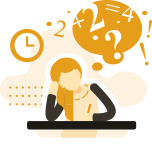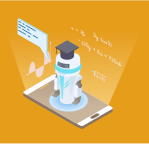It’s now quite apparent that the COVID-19 pandemic has globally accelerated technology adoption and even more so in the education industry, where digitalization has been rapid. Technology is transforming the fundamental ways of teaching and learning. AI is the disruptive technology democratizing access to education and infusing great experiences for all the stakeholders, i.e., tutors, students, and institutions. But is there more to the role of AI in education sector than to simply automate a few laborious tasks?
In this blog, we will examine the role of AI in education and find out whether AI is a threat to tutors or if it will augment the current teaching capacity?
Artificial Intelligence (AI)
As a broad definition, AI is a term for machines that can sense their environment, think, learn and respond to their senses to get to their objectives. AI, by definition, is a branch of science making and studying machines intended to stimulate the process of human intelligence. The main objective of AI is to optimize routine procedures, improve their speed and efficiency.


Over Burdened Teachers!
The teaching profession is getting more complex by the day. Teachers are burdened with more complicated administrative and paperwork tasks. According to a recent Microsoft and McKinsey survey, teachers work an average of over 50 hours a week. While there is further discouragement for the teaching profession with a talk by some of the industry leaders that emerging technologies such as AI can replace teachers, the good news is that teachers are not going away any time soon. But the use of AI in teaching will increase in future. The report suggests that the demand for teachers will grow moderately in advanced economies and by as much as 100 percent in economies such as India.

AI - A Hero in Augmenting teaching
The real potential of AI coming to fruition will depend on how educators leverage the power of AI in teaching to augment teachers in their everyday work by ensuring that the routine and repetitive tasks less consume them. The adoption of AI solutions with the idea of augmentation can help solve administrative problems, including curriculum adherence, and automate tasks such as formative assessments. In turn, usage of AI and ML in education will help teachers spend more meaningful time with their students and develop new learning opportunities.
Role of AI in Education
While, in theory, the applicability of AI in teaching seems limitless, here are a few real-world use cases of where you will understand how can AI be used in education and deliver transformative outcomes.


Role of AI in Virtual Reality (VR) & Augmented Reality (AR) for Immersive Learning
While VR & AR are still nascent technologies and have a few challenges to overcome before they become mainstream, despite the challenges, these technologies are already being embraced by many educators, and the demand is expected to grow in the coming years.
In addition to students gaining immersive learning experiences, AR & VR in education can spark creativity and imagination to explore new avenues. These technologies can aid students when they find certain academic concepts difficult to understand in a theoretical form.
Some of the other benefits that we already see today are providing students with social and cultural experiences that probably would not be possible for all students to experience. For example, a VR trip to Peru or Congo basin can help students gain exposure to cultures and regional nuances other than their own. In today’s interconnected world, the ability to understand and look at people from different perspectives is an important skill.
Learning by Doing
When teaching, few of the experiments conducted in the real world may be dangerous or even very expensive. By simulating real-world environments, AR & VR can aid students in practical learning. These technologies also apply to some professions where many hours of training are required to gain proficiency—for example, surgeons or pilots. Using AR & VR, students gain knowledge without having to worry about any operational limits. AR, VR, and AI are distinct technologies, and AI helps create dynamic Unser interfaces and helps.
Personalize each user’s experience. For example, in AR, a 3D representation of the natural world is constructed so that digital objects can co-exist with real-world objects. AI models are then used to build a map of the world and track motion within it. Thanks to the incredibly powerful deep neural nets, the realistic occlusion and inference of 3D objects in real-time are now possible.
Concerns about application of AI in Education
AI is a fast-developing technology and is outpacing policy and oversight. This development, in turn, raises many questions for educators and technology leaders to consider. Let’s look at a few examples.
1. How can students’ privacy and data be protected?
Most of the existing off-the-shelf tools for AI in online education have been built for commercial purposes and not specifically designed for an educational environment. They have not been designed to support school system compliances nor with any student privacy laws. Without adequate data protection, the use of AI-driven applications may put students at risk for future discrimination.
2. Will AI exacerbate the digital divide in society with biases and unequal impact?
AI is a technology that learns by applying algorithms to large data sets. The data often has flaws with the prevalence of gender, racial, religious, and regional biases. These biases could manifest in many forms, including how a platform teaches specific skills or grades answers. It could even wrongfully label a student simply because the algorithm is biased and does not recognize their behavior. AI algorithms that leverage these data sets or data from books, news articles, and other forms of media can further perpetuate this bias.

The Future
While traditional education has many boundaries, AI can help erase the boundaries by making learning accessible to everyone. Additionally, AI will make education more personalized and flexible. Today one doesn’t need to travel to a physical location to learn. Anyone can learn at any point in their lives and get 24/7 support. Students will need to work alongside AI to be better prepared to face the unknown challenges in the future workplace.
AI is already transforming education and dramatically changing how we learn and teach. These were just a few examples of how AI is shaping the industry. We believe the power and capabilities of AI in education are not fully explored. The best of AI is yet to come!
You can now leverage the power of AI to drive your next innovation. Clairvoyant is a global technology consulting and services company. We help organizations build innovative products and solutions using AI, ML, Big data, Analytics, and the Cloud.
Our deep knowledge of the education industry, combined with expertise on multiple enterprise-grade big data platforms, helps support purpose-built solutions to meet our client’s business needs.
Our global team consists of experienced professionals in design, software engineering, analytics, and data science. Each member of our team is highly energetic and committed to helping our clients achieve their goals.